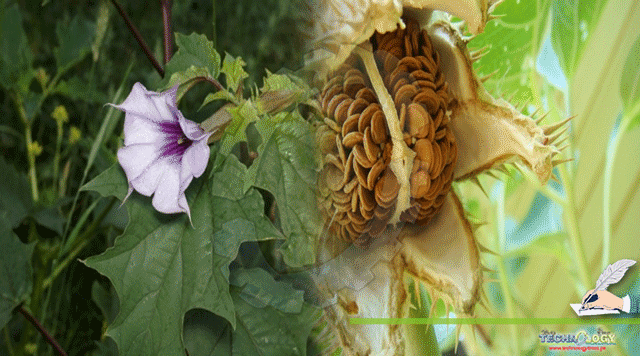Datura is obtained from Dhatura which is the Bangli name. It is also known as jimson weed or thorn apple, genus of almost 9-12 species, which is a flowering plant of nightshade family.

By Ammara Akhtar, Athar Mahmood, Maria Naqve
Botanical Name: Datura stramonium
Common Name: Stinkweed
Family: Solanaceae
All parts of this plant like stem, leaf, roots and flowers are poisonous that leads to a great number of accidental death every year. Each species has its own attributes like strong narcotics tropane alkaloids usually scopolamine, daturine, stramonine etc that make it more hazardous and toxic among plants. Since many years it is used as medicines, drugs and ritual alcoholic agent. Grows mainly in sunny and temperate climates. It’s cultivated as common garden plant because their flowers are attractive. This is 60-120 cm tall, subdivide and growing plant. Ingestion of even a small quantity of any part of plant can leads to coma, strong illusion or sometime cause death. Its importance is as follows:
Importance:
This plant is an herbaceous annual or short lived perennial, seeds are produced from small, circular fruit like capsule covered in preservative spines that’s why known as thorn apple, which contains strong alkaloids such as atropine, scopolamine and hyoscyamine and distributed mainly in India, Europe, Greece and Rome. In 1830’s the first active alkaloid (atropine) was isolated. Throughout the world it is used as pharmacological as well as traditional medicines. It is a natural source of antioxidant and phytochemical which have antimicrobial activity. We can increase the production of datura plant by increasing in nitrate concentration in culture of roots of datura caused the increase of biomass production but control alkaloid tropane biosynthesis.
Traditional uses:
To treat Parkinson’s disease, gastric ulcer, asthma etc atropine has used. Its leaves may be sticked and mixed with Poly Vinyl Pyrrolidone used as a matrix that forms material which is used in making sustained release matrix tablets. By the combnation of Datura Stramonium leaves and mustard oil we can use it for the treatment of skin diseases. In Eastern medicines for the treatment of various human diseases like ulceration, rheumatism, swelling, temperature, teeth pain etc. Juice of flowers is used in ears pain. Seeds are used in cough, fever and also used to smoke etc. Water extract show insecticidal activity and ethanol extract show antimicrobial activities. It is commonly used as antiparasitic or as a repellent. Fruit oil is used for body pain.
Pharmacological uses:
The anticolinergic effect of alkaloids such as atropine, scopolamine, hyoscyamine used in the treatment of organ phosphate exposure. These alkaloids can cause central nervous system stimulation when take in low quantity while taking in high quantity it cause depression. Its effects show after 30 minutes after taking it. Physostigmine is used to reduce severe anticolinergic symptoms. Physostigmine is a substrate for acetyl-cholinesterase that inactivates its effects. The secondary metabolites of Datura stramonium are highly effective against different types of diseases such as ant diabetic, antiviral, etc. Water extract of show insecticidal activities. In Eastern medicine, especially in Ayurvedic medicine for curing various human ailments, including ulcers, wounds, inflammation, rheumatism and gout, sciatica, bruises and swellings, fever, asthma, bronchitis and toothache it has been used. The ethanolic extracts show good antimicrobial activities than aqueous extracts. Extracts of leaves show better efficacy then stem and root.
Homoeopathic uses:
It’s homeopathically used in epilepsy as well as in other forms of spasmodic disease. It is remarkable, however, that it produced convulsions which are partial, rather than general, which is being affected the arms rather than the lower extremities also, isolated groups of muscles. Thus, twitching of the extremities and of the facial muscles, jerkings of the head, etc may be seen. Datura stramonium is indicated in the second stage of delirium tremens. It has tried and has admirable success.
Other Uses:
The growing plant is said to be protected the neighboring plants from insects. Reports on the use of the plant as an insecticide vary from good control of aphids in crops in Namibia to no effects in Australia. To cure dandruff and falling hair the juice of the fruits is applied in the scalp. The leaves yield a green dye that is used to dye cloth. The twigs yield a blue-green dye that is used for house decoration. The plant has been used to tattoo the gums, partly as a treatment of gingivitis or dental decay. The seed contains about 17% of pale yellow oil. It is used as massage oil. The stems are used as firewood.
Datura side effects:
Datura is a poisonous plant, so it should be taken only after consultation with experienced physicians. Its chemicals such as scopolamine and atropine are used as poison and used in murders and suicides. It increases the heartbeat and may lead to cardiac arrest. Ingesting datura may cause violent behavior because of the presence of chemical substances called anticholinergic. Taking datura results in dilated pupils. One can also experience amnesia due to this. Blurred vision, nausea, giddiness, confusion, rapid pulse, hyperthermia are some of the side effects of datura. Datura can affect the nervous system adversely. The juice of datura leaves is also very harmful to the eyes.
Gyanunlimited – A Hub of Alternative Medicine and Holistic Health
Authors : Ammara Akhtar, Athar Mahmood, Maria Naqve University Of Agriculture Faisalabad